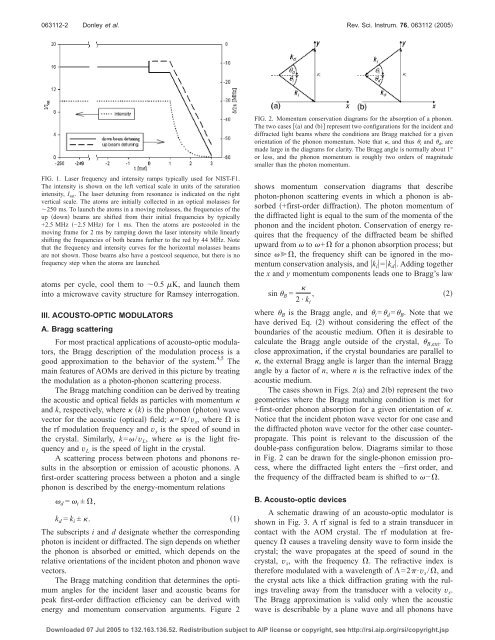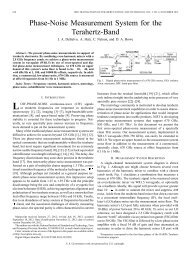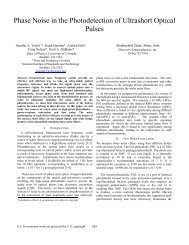Double-pass acousto-optic modulator system - National Institute of ...
Double-pass acousto-optic modulator system - National Institute of ...
Double-pass acousto-optic modulator system - National Institute of ...
You also want an ePaper? Increase the reach of your titles
YUMPU automatically turns print PDFs into web optimized ePapers that Google loves.
063112-2 Donley et al. Rev. Sci. Instrum. 76, 063112 �2005�<br />
FIG. 1. Laser frequency and intensity ramps typically used for NIST-F1.<br />
The intensity is shown on the left vertical scale in units <strong>of</strong> the saturation<br />
intensity, I sat. The laser detuning from resonance is indicated on the right<br />
vertical scale. The atoms are initially collected in an <strong>optic</strong>al molasses for<br />
�250 ms. To launch the atoms in a moving molasses, the frequencies <strong>of</strong> the<br />
up �down� beams are shifted from their initial frequencies by typically<br />
+2.5 MHz �−2.5 MHz� for 1 ms. Then the atoms are postcooled in the<br />
moving frame for 2 ms by ramping down the laser intensity while linearly<br />
shifting the frequencies <strong>of</strong> both beams further to the red by 44 MHz. Note<br />
that the frequency and intensity curves for the horizontal molasses beams<br />
are not shown. Those beams also have a postcool sequence, but there is no<br />
frequency step when the atoms are launched.<br />
atoms per cycle, cool them to �0.5 �K, and launch them<br />
into a microwave cavity structure for Ramsey interrogation.<br />
III. ACOUSTO-OPTIC MODULATORS<br />
A. Bragg scattering<br />
For most practical applications <strong>of</strong> <strong>acousto</strong>-<strong>optic</strong> <strong>modulator</strong>s,<br />
the Bragg description <strong>of</strong> the modulation process is a<br />
good approximation to the behavior <strong>of</strong> the <strong>system</strong>. 4,5 The<br />
main features <strong>of</strong> AOMs are derived in this picture by treating<br />
the modulation as a photon-phonon scattering process.<br />
The Bragg matching condition can be derived by treating<br />
the acoustic and <strong>optic</strong>al fields as particles with momentum �<br />
and k, respectively, where � �k� is the phonon �photon� wave<br />
vector for the acoustic �<strong>optic</strong>al� field; �=�/v s, where � is<br />
the rf modulation frequency and vs is the speed <strong>of</strong> sound in<br />
the crystal. Similarly, k=�/v L, where � is the light frequency<br />
and vL is the speed <strong>of</strong> light in the crystal.<br />
A scattering process between photons and phonons results<br />
in the absorption or emission <strong>of</strong> acoustic phonons. A<br />
first-order scattering process between a photon and a single<br />
phonon is described by the energy-momentum relations<br />
� d = � i ± �,<br />
kd = ki ± �. �1�<br />
The subscripts i and d designate whether the corresponding<br />
photon is incident or diffracted. The sign depends on whether<br />
the phonon is absorbed or emitted, which depends on the<br />
relative orientations <strong>of</strong> the incident photon and phonon wave<br />
vectors.<br />
The Bragg matching condition that determines the optimum<br />
angles for the incident laser and acoustic beams for<br />
peak first-order diffraction efficiency can be derived with<br />
energy and momentum conservation arguments. Figure 2<br />
FIG. 2. Momentum conservation diagrams for the absorption <strong>of</strong> a phonon.<br />
The two cases ��a� and �b�� represent two configurations for the incident and<br />
diffracted light beams where the conditions are Bragg matched for a given<br />
orientation <strong>of</strong> the phonon momentum. Note that �, and thus � i and � d, are<br />
made large in the diagrams for clarity. The Bragg angle is normally about 1°<br />
or less, and the phonon momentum is roughly two orders <strong>of</strong> magnitude<br />
smaller than the photon momentum.<br />
shows momentum conservation diagrams that describe<br />
photon-phonon scattering events in which a phonon is absorbed<br />
�+first-order diffraction�. The photon momentum <strong>of</strong><br />
the diffracted light is equal to the sum <strong>of</strong> the momenta <strong>of</strong> the<br />
phonon and the incident photon. Conservation <strong>of</strong> energy requires<br />
that the frequency <strong>of</strong> the diffracted beam be shifted<br />
upward from � to �+� for a phonon absorption process; but<br />
since ���, the frequency shift can be ignored in the momentum<br />
conservation analysis, and �ki�=�k d�. Adding together<br />
the x and y momentum components leads one to Bragg’s law<br />
sin �B = �<br />
, �2�<br />
2·ki where �B is the Bragg angle, and �i=� d=� B. Note that we<br />
have derived Eq. �2� without considering the effect <strong>of</strong> the<br />
boundaries <strong>of</strong> the acoustic medium. Often it is desirable to<br />
calculate the Bragg angle outside <strong>of</strong> the crystal, �B,ext. To<br />
close approximation, if the crystal boundaries are parallel to<br />
�, the external Bragg angle is larger than the internal Bragg<br />
angle by a factor <strong>of</strong> n, where n is the refractive index <strong>of</strong> the<br />
acoustic medium.<br />
The cases shown in Figs. 2�a� and 2�b� represent the two<br />
geometries where the Bragg matching condition is met for<br />
+first-order phonon absorption for a given orientation <strong>of</strong> �.<br />
Notice that the incident photon wave vector for one case and<br />
the diffracted photon wave vector for the other case counterpropagate.<br />
This point is relevant to the discussion <strong>of</strong> the<br />
double-<strong>pass</strong> configuration below. Diagrams similar to those<br />
in Fig. 2 can be drawn for the single-phonon emission process,<br />
where the diffracted light enters the −first order, and<br />
the frequency <strong>of</strong> the diffracted beam is shifted to �−�.<br />
B. Acousto-<strong>optic</strong> devices<br />
A schematic drawing <strong>of</strong> an <strong>acousto</strong>-<strong>optic</strong> <strong>modulator</strong> is<br />
shown in Fig. 3. A rf signal is fed to a strain transducer in<br />
contact with the AOM crystal. The rf modulation at frequency<br />
� causes a traveling density wave to form inside the<br />
crystal; the wave propagates at the speed <strong>of</strong> sound in the<br />
crystal, v s, with the frequency �. The refractive index is<br />
therefore modulated with a wavelength <strong>of</strong> �=2�·v s/�, and<br />
the crystal acts like a thick diffraction grating with the rulings<br />
traveling away from the transducer with a velocity v s.<br />
The Bragg approximation is valid only when the acoustic<br />
wave is describable by a plane wave and all phonons have<br />
Downloaded 07 Jul 2005 to 132.163.136.52. Redistribution subject to AIP license or copyright, see http://rsi.aip.org/rsi/copyright.jsp





